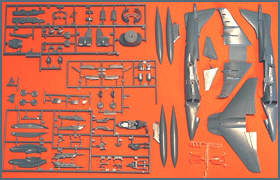
          
|
What is Scale Modeling?By Mike Gilsbach, ASMS Webmaster One of the stated goals of the Austin Scale Modeler's Society is to promote the hobby of scale modeling, which includes attracting new people to the hobby. My intention with this article is to provide the uninitiated, but interested reader with a quick overview of scale modeling as a hobby. What is scale modeling? Scale modeling, at least in hobby terms, consists of creating miniature representations (models) of larger subjects. While models may be constructed from any material, most modelers use plastic kits that are glued together and painted. Most people tend to think of model airplanes, cars or ships. However, the subject that is represented can be literally anything. Modelers build figures, tanks and artillery pieces, dinosaurs, science-fiction subjects, landscapes, buildings, and many, many other things. Virtually anything real or imagined can be the subject of a scale model. Take a look at the ASMS photo gallery and you should get some idea as to the diversity of modeling subjects that are available. What does the "scale" part mean? In order to accurately represent their subject, a model must be "to scale". This means that all of the proportions of the model match those of the real thing. When modelers talk about scale, they are talking about the relationship between the size of the model and the size of the object the model represents. This is usually described as a numeric ratio like 1:72 or 1:48. This numeric ratio tells you that one measurement (inch, foot, etc.) equals the second number of the same measurement on the real object. For example, 1:72 scale means that 1 inch on the model represents 72 inches on the actual subject. So, a 1:72 scale model of a six-foot (seventy-two-inch) tall soldier would be one inch tall. A number of standard scales have been adopted for various types of models that more or less fit the size of the subjects they represent and allow for a practical-sized model. The table below shows a few of them.
There are many other scales besides the ones listed above. In addition, many kits come in "box scale", which means that the kit was engineered so that the unbuilt model would fit in a certain size box. Modelers just build kits, right? That is only partially true. Most modelers will at least start with a manufactured plastic kit. These kits are available at hobby shops, craft stores, toy stores and some large retailers as well as from many online suppliers. They are produced by one of the hundreds of kit manufacturers all over the world and they vary considerably in both price and quality. While kits may be purchased for as little as $5, some high-quality complex kits cost hundreds of dollars. A typical model kit includes the plastic parts of the kit molded on sprues, or parts trees (see the figure below). The parts must be cut from the sprues prior to assembly. The parts will usually be molded in one color of plastic, though some kits come molded in more than one color. If the kit has clear parts, such as windows or headlights, those parts will be on a separate sprue of clear plastic, as seen in the bottom right part of the figure below.
In addition to the plastic parts, a kit normally includes an instruction sheet, which gives you some background information on the subject as well as detailed diagrams showing how the parts should be assembled and painted. The kit might also include a set of decals for things like numbers, letters, national insignia and other details for the model. Finally, many kits include what are called multimedia items (not plastic) that add specialized detail to the model. These may include vinyl (tires and tank treads), aluminum or brass (gun barrels and shells) and resin or photoetch parts (for highly intricate or detailed components). For many modelers, however, the kit is just a starting point - a base on which to build. Modelers may add after-market parts or decals. They may modify the kit to be a different subject, such as an earlier or later variant of a vehicle. They might make their own decals or scratch build their own parts. They may create a base on which to display their model that includes scenery like buildings or landscape or may combine several models to create a scene. Even building a kit straight "out of the box", however, can have many challenges if you want to produce a realistic model. What's involved in actually building a model kit? Building a model can be divided into three main types of activity:
How do I get started? If you have never built a model, or haven't built one in a very long time, the best place to start is your local hobby shop. The staff there will be able to help you choose a kit that is suited to your experience level and to stock up on the supplies you will need to build it. IPMS has an online directory of local hobby shops. Attending a meeting of your local IPMS (International Plastic Modeler's Society) chapter is another great way to start or reacquaint yourself with the hobby. The IPMS web site maintains a directory of local chapters. Finally, there are a number of online discussion forums devoted to scale modeling where you can ask questions of other modelers, many of whom have many years of experience. These include the IPMS Forum, the Hyperscale Discussion Forums, and the Aircraft Resource Center Forums to name just a few. |
© Copyright 2025, Austin Scale Modelers Society (ASMS)
